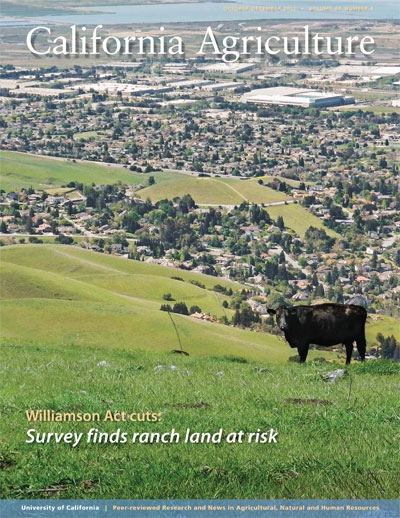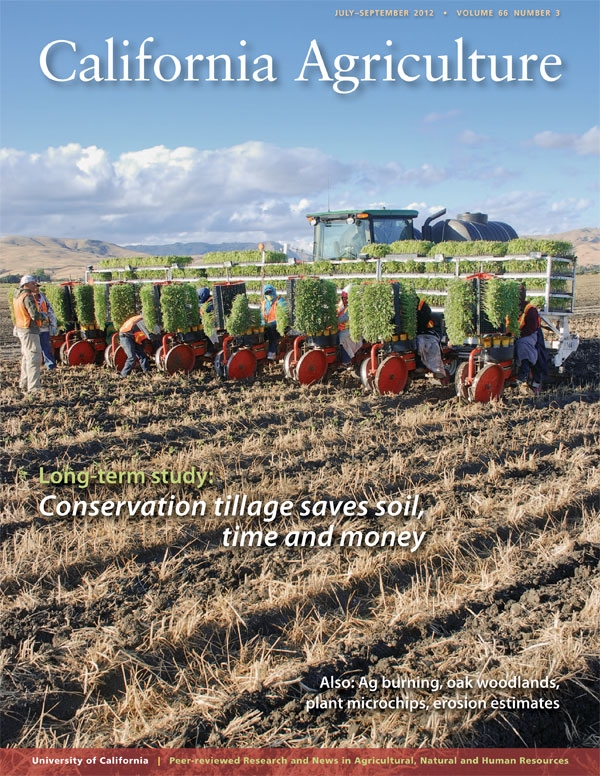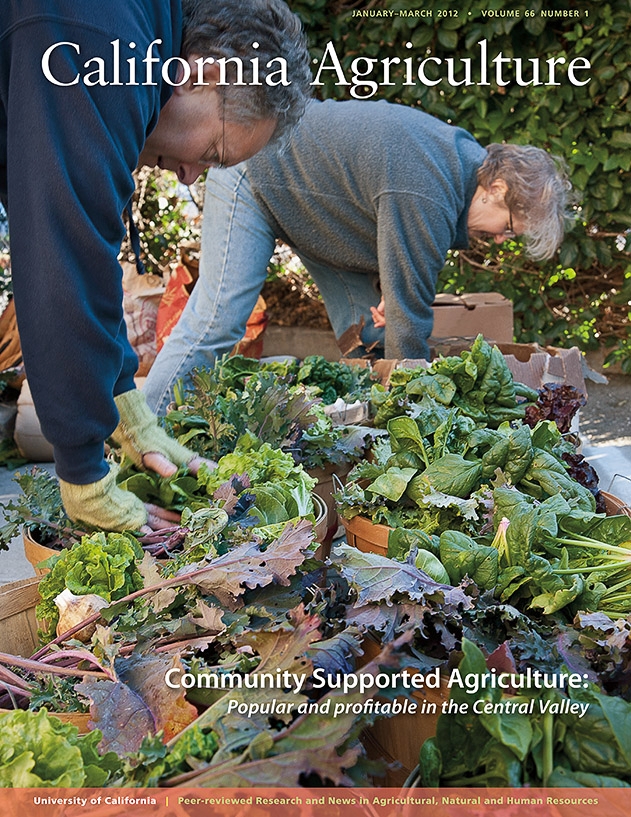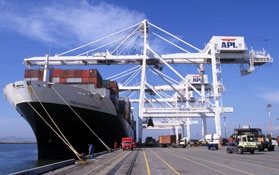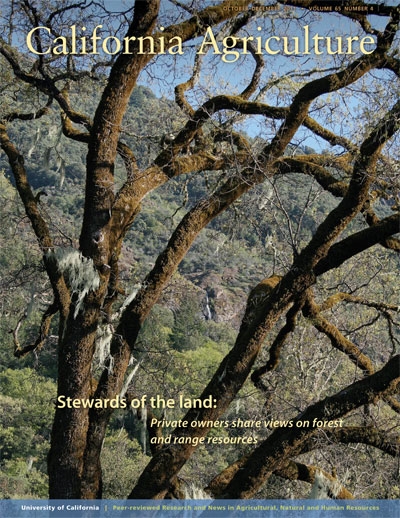Posts Tagged: California Agriculture journal
Williamson Act cuts: Ranch land, critical conservation areas, at risk
State budget cuts have dramatically reduced funding for the Williamson Act, California’s conservation law that provides property tax relief for the owners of 15 million acres of rangeland and farms — preserving California’s prized open space.
New research reveals that if cuts continue and the act is eliminated, owners of ranchland plan to sell 20 percent of their total acres, according to William Wetzel and his co-investigators. Wetzel is a doctoral candidate in the UC Davis Department of Evolution and Ecology. The findings appear in the October–December 2012 California Agriculture, UC’s peer-reviewed research journal.
“In all, 37 percent of ranchers predicted they would sell some or all of their rangeland without support from the act,” Wetzel said. “Of those who would sell, 76 percent predicted buyers would develop the land for nonagricultural uses — suggesting that a significant amount of California’s open space could be lost.”
For smaller ranchers, tax relief often means the difference between a small profit and a loss, he and his colleagues found. They surveyed 700 ranchers who have Williamson Act contracts, randomly selected from act participants whose land comprises 15 million acres of working ranches and farms. Researchers asked ranchers for plans under a hypothetical elimination scenario.
Under the 1965 act, landowners promise to keep their property in agricultural use for set periods (originally, 10 years at a time). In exchange, they receive significant reductions in property taxes. The state reimbursed counties for most of the lost tax revenue until 2009, when the state virtually eliminated its contribution.
The scientists used both a written questionnaire and geospatial analysis to assess the impacts of eliminating the act. The geospatial analysis revealed that 72 percent of rangeland parcels enrolled in Williamson Act contracts contained habitat “important” or “critical” for statewide conservation goals, as defined by the California Rangeland Conservation Coalition. The Coalition designates 43 percent of enrolled parcels as “critical” for statewide conservation goals.
“Thousands of farmers and ranchers in 53 of California’s 58 counties have participated in Williamson contracts,” said Iara Lacher, co-author and UC Davis doctoral candidate. “California rangelands not only provide forage for cattle, they encompass unique ecosystems that provide habitat for threatened and endangered species. They also form most of the major drainage basins of the state, constantly filtering and purifying the water supply.”
Almost all of California's surface water, including drinking water for millions of people, passes through rangeland. This land -- grasslands, oak woodlands, wetlands, shrublands and desert -- accounts for 57 million of the state's 101 million acres, according to the California Department of Forestry and Fire Protection. Of that, most is used for grazing, 34 million acres. Grazed land itself consists of 18 million privately owned, and 16 million publicly owned, acres (the latter leased for grazing).
Rangeland accounts for more than 10 million acres under Williamson contracts; 5 million acres are prime farmland. Rangeland is considered “non-prime” because the soil is less fertile than that used for intensive agriculture. The distinction depends on the per-acre production potential of a parcel of land.
“Rangeland can provide many ecosystem services precisely because it is not put to intensive use, unlike suburban developments or irrigated agriculture,” Wetzel explained. At the same time, grazed land is the rangeland most at risk of conversion, with the current rate estimated to be 47,000 acres per year. Of ranchers surveyed, 72 percent considered the Williamson Act to be “extremely important” to their operations; 23 percent said they were likely or very likely to end their entire ranching enterprise if they lost this tax relief.
“California ranching is a vulnerable, low-profit industry,” said Dale Manning, study co-author and UC Davis doctoral candidate. “Of those surveyed, 38 percent lost money, 19 percent roughly broke even, and 42 percent made a profit. Of the ranches that made a profit in 2009, 70 percent made less than $10,000.”
Under the original Williamson Act program, contract-holding counties received annual subvention (financial assistance) payments from the state in proportion to their enrollment and to the productivity of the enrolled lands. These funds helped compensate for the tax revenue losses counties faced due to their participation.
Beginning in budget year 2008–2009, California drastically reduced subvention reimbursements to counties as part of a plan to phase out the program. In 2009–2010, California Governor Arnold Schwarzenegger cut state subvention funding to $1,000, essentially eliminating state support.
Before subvention payments were cut, state reimbursements to counties ranged from $5.2 million in heavily agricultural counties such as Fresno, Kern and Tulare to less than $12,000 in more urbanized counties such as Orange and San Bernardino. In 2010, in response to subvention payment loss, Imperial County ended its participation in the program, allowing contracts to expire countywide.
Under mounting budget deficits, a number of counties have placed a moratorium on new Williamson Act contracts because of uncertainty surrounding the future of subvention payments.
The research article, and the entire October–December 2012 issue, can be downloaded at http://californiaagriculture.ucanr.edu.
California Agriculture is the University of California’s peer-reviewed journal of research in agricultural, human and natural resources. For a free subscription, go to: http://californiaagriculture.ucanr.edu, or write to calag@ucanr.edu.
WRITERS/EDITORS: To request a hard copy of the journal, e-mail crllopez@ucanr.edu.
MEDIA CONTACT: William Wetzel, Williamson Act study author, doctoral candidate, Department of Evolution and Ecology, UC Davis, (914) 552-7482, William.wetzel@gmail.com. Available on October 26 and after Nov. 1.
Dan Swezey, UC Davis doctoral candidate and study co-author, is an alternate contact when Wetzel is unavailable, (831) 345-6108, dsswezey@ucdavis.edu.
Rangeland data was taken from the California Department of Forestry and Fire Protection 2010 publication, California’s Forests and Rangelands: 2010 Assessment. http://frap.fire.ca.gov/assessment2010/pdfs/california_forest_assessment_nov22.pdf.
Long-term study: Conservation tillage saves oil, soil and toil in cotton
A 12-year study published in the July-September 2012 issue of the University of California’s California Agriculture journal demonstrates that cotton grown in rotation with tomatoes — using lower-impact conservation tillage — can achieve yields similar to standard cultivation methods and at lower cost.
Conservation tillage seeks to reduce the number of times that tractors cross the field, in order to protect the soil from erosion and compaction, and save time, fuel and labor costs. Cotton crops are planted directly into stubble from the previous crop in the rotation.
In the study, conducted from 2000 to 2011 at the UC West Side Research and Extension Center in Five Points (southwest of Fresno), the number of tractor passes for a cotton-tomato rotation grown with a cover crop was reduced from 20 in the standard treatment to 13 with conservation tillage.
By the final years of the in the San Joaquin Valley study, cotton lint yields were statistically equivalent and even higher (in 2011) than with standard cultivation methods.
“The UC studies have consistently shown that conservation tillage can yield as well as standard tillage in a cotton-tomato rotation,” lead author Jeffrey P. Mitchell, UC Cooperative Extension specialist in the Department of Plant Sciences at UC Davis, and co-authors wrote in California Agriculture journal.
Their study, “Conservation tillage systems for cotton advance in the San Joaquin Valley,” as well as the entire July-September 2012 issue of California Agriculture journal, can be viewed and downloaded online at: http://californiaagriculture.ucanr.edu.
Mitchell is a founder of Conservation Agriculture Systems Innovation (CASI), a diverse group of more than 1,800 farmers, industry representatives, UC and other university faculty, and members of the Natural Resources Conservation Service and other public agencies (http://ucanr.edu/CASI). CASI defines conservation tillage as a suite of cultivation practices — including no-tillage, minimum tillage, ridge tillage and strip tillage — that reduce the volume of soil disturbed and preserve crop residues in the field. Conservation tillage is common in other regions of the United States and parts of the world and is beginning to gain acceptance in California agriculture.
Technological upgrades to tillage implements have been critical to the advancement of conservation tillage systems. These include equipment that can target operations to just the plant row rather than the whole field as well as accomplish several operations at the same time.
Fuel use was reduced by 12 gallons and labor by 2 hours per acre in the conservation tillage plots. This amounted to savings of about $70 per acre in 2011 dollars.
Mitchell noted that more research is needed on the adequate development of cotton stands and the prevention of soil compaction under different conditions, but that the benefits of conservation tillage are becoming increasingly obvious. “Provided that yield performance or more importantly bottom-line profitability can be maintained and the risks associated with adopting a new tillage system are deemed reasonable, conservation tillage systems may become increasingly attractive to producers and more common in San Joaquin Valley cotton-growing areas.”
Also in the July-September 2012 issue of California Agriculture:
Agricultural burning and air quality: Southern California farmers in Imperial County regularly burn crop residues of bermudagrass in the winter and wheat stubble in the summer. A study of ambient air quality adjacent to and downwind of agricultural burning sites in the desert county found that particulate matter levels (PM2.5) were 23% higher on burn days than on no-burn days at four locations. Researchers from the California Department of Public Health also assessed community educational needs regarding agricultural burning and developed fact sheets in English and Spanish targeting the general public, schools and farmers.
The value of privately owned oak woodlands: More than 80 percent of California’s 5 million oak woodland acres are privately owned. In a survey, researchers from Spain and UC Berkeley asked private owners of California oak woodlands to place a monetary value on amenities from their land such as recreation, scenic beauty or a rural lifestyle. The technique, called “contingent valuation,” found that landowners would be willing to pay $54 per acre annually for private amenities from their land and that their willingness to pay per acre decreased as their property size increased.
Microchips for woody plants: Radio-frequency identification (RFID) tags are widely used to track books in libraries, products during manufacturing, cattle from rangeland to the slaughterhouse, inventory in retail, runners in road races and much more. These tiny microchips (often the size of a grain of rice) are now being placed in woody plants such as grapevines and orchards to monitor crop diseases, track irrigation and pesticide applications, and help prevent the theft of valuable plants. In this review, Italian researchers discuss the emerging uses of RFID technology in agriculture.
Rainfall simulators to measure erosion: In their efforts to keep Lake Tahoe clear, researchers have been studying the movement of sediments into the lake using rainfall simulators. These fairly simple machines are placed on a slope; “rain” is created over a small frame, which allows sediment in the runoff to be collected and measured. However, the lack of standardization in erosion studies using rainfall simulators may be hampering progress. Mark Grismer, professor in the Department of Land, Air and Water Resources at UC Davis, makes the case for standardized field methodologies and data analysis.
###
California Agriculture is the University of California’s peer-reviewed journal of research in agricultural, natural and human resources. For a free subscription, go to: http://californiaagriculture.ucanr.edu, or write to calag@ucanr.edu.
WRITERS/EDITORS: To request a hard copy of the journal, e-mail jlbyron@ucanr.edu.
Community Supported Agriculture grows rapidly in California’s Central Valley
Community Supported Agriculture (CSA) — farms that regularly provide fresh produce directly to members — is growing rapidly in California’s Central Valley and surrounding foothills, according to a new study published in the January–March 2012 issue of the University of California’s California Agriculture journal.
Total membership in the CSAs surveyed (n = 46) increased exponentially from an estimated 672 members in 1990 to 32,938 members in 2010. Most CSAs in California’s Central Valley and surrounding foothills were relatively small (20 acres on average), produced a broad range of crops (44 on average) and adhered to organic or sustainable growing practices.
Likewise, 54 percent of the CSA farms surveyed were profitable; of the rest, 32 percent broke even and 15 percent operated at a loss. Gross average sales for the CSAs surveyed were $9,084 per acre in 2009; this compares with average gross sales of $1,336 per acre for California agriculture in general.
Despite their increasing popularity, little is known about CSA farmers and their operations. UC researchers conducted a comprehensive study of CSA farmers in the Central Valley and surrounding foothills about their growing practices, farm economics, demographics and other characteristics. The article in full and the entire January–March 2012 issue of California Agriculture can be found at: http://californiaagriculture.ucanr.org.
CSAs eliminate distributors, forging direct connections between farmers and consumers; California has about 275 CSAs, and there are more than 3,500 nationally. The researchers found that CSAs are adapting and changing to meet consumer interest in and demand for locally produced food.
“Together with farmers markets, farm stands, U-picks and agritourism, CSAs constitute a ‘civic agriculture’ that is re-embedding agricultural production in more sustainable social and ecological relationships, maintaining economic viability for small- and medium-scale farmers and fulfilling the non–farm-based population's increasing desire to reconnect with their food,” Ryan Galt, UC Davis assistant professor in the Department of Human and Community Development, and co-authors wrote in California Agriculture journal.
The CSA model has undergone considerable change and innovation, the researchers found, with growers offering new products such as meat and dairy and making payment options more attractive to consumers. When the first CSAs were started on the East Coast in the mid-1980s, members paid in advance and received a share of the farm’s crop in return, and they also shared in production risks. Today’s CSAs allow consumers more flexibility and less risk. “Twenty percent of CSAs in the study had no minimum payment period, allowing week-by-week payments, which extends membership to a broader population, including those hesitant or unable to commit to extended payments,” the authors wrote.
The study team also interviewed CSA farmers about what motivated them. “Even though a CSA is hard work, farmers tend to find it rewarding,” Galt and co-authors noted. “The vast majority were happy with their work and continued to view the CSA as a viable option for small- and medium-scale farmers.”
Also in the January–March 2012 issue of California Agriculture:
Farm-to-WIC study: The federal Special Supplemental Nutrition Program for Women, Infants and Children (WIC) now distributes monthly cash vouchers to low-income women with children to buy fruits and vegetables. UC Cooperative Extension (UCCE) researchers surveyed WIC participants in Tulare, Alameda and Riverside counties in 2010 to guide the development of a farm-to-WIC program that would connect local growers to the WIC market. Based on WIC participants’ produce preferences and buying habits, they developed a list of 19 produce items for possible inclusion in the program, including broccoli, cabbage, collards, nopales, sweet potato and tomatillo.
Preventing Fusarium wilt of lettuce: Caused by the soilborne fungus Fusarium oxysporum f. sp. lactucae, Fusarium wilt affects all major lettuce production areas in California and Arizona. In trials at UC Davis, lettuce cultivars differed significantly in susceptibility to the disease, with some leaf and romaine types highly resistant under all test conditions. Management of Fusarium wilt requires an integrated approach that includes crop rotation to reduce soil inoculum levels and the use of resistant cultivars during the warmest planting windows.
Also in the online-only E-Edition of California Agriculture:
Biological control for citrus pests: In a spring 2010 survey and statistical analysis, growers with greater citrus acreage and more education were more likely to use biological controls for four important citrus pests (California red scale, citrus red mite, citrus thrips and cottony cushion scale). Marketing outlets, ethnicity and primary information sources also influenced the extent of reliance on beneficial insects.
California Agriculture is the University of California’s peer-reviewed journal of research in agricultural, human and natural resources. For a free subscription, go to: http://californiaagriculture.ucanr.org, or write to calag@ucdavis.edu.
WRITERS/EDITORS: To request a hard copy of the journal, e-mail jlbyron@ucdavis.edu.
UC economists project farm export gains from free trade agreements
Analysis of the recently approved United States free trade agreement with South Korea in the April-June 2011 issue of the California Agriculture journal shows how California farm exports will now have much improved access to the large South Korean market, significantly enhancing competitive prospects for almonds, walnuts, dairy products, beef and oranges, among other important California commodities.
Legislation implementing the Korea free trade agreement, along with smaller agreements with Colombia and Panama, were negotiated several years ago. They finally gained Congressional approval on Oct. 12 and are set to be signed by President Obama on Oct. 21.
By phasing out or eliminating tariffs and other trade barriers, free trade agreements create larger markets for California-produced farm commodities. Since South Korea has no significant prospects to export farm goods to the United States, California agriculture is a clear winner from this agreement.
Hyunok Lee and Daniel Sumner from the Department of Agricultural and Resource Economics at UC Davis and the UC Agricultural Issues Center document the current importance of South Korea to California farm exports, the size of the trade barriers these exports have faced (many facing tariffs of more than 30 percent) and the advantages currently afforded by South Korea’s existing free trade agreements with important competitors, such as Chile and Australia.
“Lower trade barriers will allow California agriculture to better compete in a large, growing and lucrative market,” said Sumner.
“Food product prices are high in South Korea and consumers are willing to pay premiums for the high-quality products produced in California,” added Lee.
South Korea has a strong economy with about 50 million consumers and per-capita income of $30,000, higher than many European countries. In 2010, the value of California farm exports to South Korea was more than $400 million. Given the size of South Korea’s economy and the high trade barriers being erased, Sumner and Lee say the accord will do more for farm exports than agreements negotiated for almost 20 years.
Among other findings, the authors report that:
- The top California ag exports to South Korea are fresh oranges, with tree nuts, rice, and beef and beef products also in the top five.
- Other California crops that hold a double-digit share of the South Korean market are hay, grape juice and kiwifruit.
- With an import tariff of about 45 percent, South Korean imports of California table grapes, fresh strawberries, fresh apples and lettuce and rice are small, but have great potential for growth.
- South Korea is becoming a major export market for California grapefruit and lemons. Lower tariffs will increase demand.
- The United States is South Korea’s only supplier for almonds and the U.S. has more than a 90 percent share of walnuts. The current 8 percent almond tariff will be eliminated and walnut tariffs will be phased out over the next 6 to 15 years.
- Beef products are the top agricultural import (from all sources) into South Korea by value. With the new agreement, the within-quota tariff will fall by 2.7 percent each year, providing a gain for U.S. producers compared to import competitors.
- South Korea has high trade barriers for many dairy products, but with gradual reductions under the new agreement, the market will grow.
MEDIA CONTACTS:
Daniel Sumner is available to comment on the free trade agreements with South Korea, Panama and Columbia. He can be reached at dasumner@ucdavis.edu, (530) 752-1668.
Hyunok Lee can comment about the size and potential growth of the Korean market. She can be reached at (530) 752-3508, hyunok@primal.ucdavis.edu.
Cell communication system prevents overirrigation of alfalfa
Scientists have developed a low-cost, high-tech system that predicts when flood irrigation will approach the end of an alfalfa field, then signals to turn it off — an innovation that could save enormous amounts of runoff from the state’s alfalfa fields.
Cultivated on 1.1 million acres, alfalfa is the largest consumer of water among all crops in California, accounting for up to 27 percent of the state’s irrigation water use. Alfalfa is usually flood irrigated, often leading to overirrigation. Water is pumped in at the top of field rows and flows down to the end. If the flow is not turned off before it reaches the bottom, substantial runoff occurs.
The new system employs sensors to track the advance of water down a field, a model that predicts when water will reach the tail end of the field, and a cellular communications system that sends a cell phone alert to the irrigator to turn off the water. It was field-tested during two seasons on the UC Davis campus; the results — zero tail water drainage from the trial fields compared with thousands of liters of runoff from control fields — are reported in the October–December 2011 issue of the University of California’s California Agriculture journal.
“Under current practice, the alfalfa irrigator makes several trips to the field to determine when the wetting front has reached a certain distance from the bottom end of the check [irrigation channel] before turning off the irrigation,” writes lead author Rajat Saha, assistant engineer for MBK Engineers in Sacramento. “Even making several trips, the irrigator may miss the wetting front advance, which results in excessive tail water drainage.”
The system, developed by Saha and coauthors at UC Davis while Saha was a UC Davis graduate student, was successfully demonstrated to dozens of farmers last year at the Alfalfa Field Day. The components are relatively inexpensive: the sensors (three per check) cost about $25 each; the data logger and modem, which can be easily moved from one location to another to reduce the initial installation investment, about $500 and $200, respectively.
If the new system, which may be commercially available in early 2012, were used for the typical five irrigations per alfalfa season, “water savings could be about 35,000 to 60,000 liters per acre,” Saha reports.
The research article, and the entire October–December 2011 issue, can be downloaded at http://californiaagriculture.ucanr.org.
California Agriculture is the University of California’s peer-reviewed journal of research in agricultural, human and natural resources. For a free subscription, go to: http://californiaagriculture.ucanr.org, or write to calag@ucdavis.edu.
WRITERS/EDITORS: To request a hard copy of the journal, email crllopez@ucdavis.edu.

